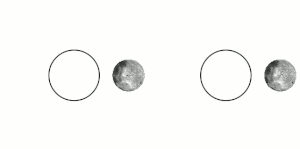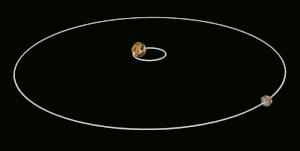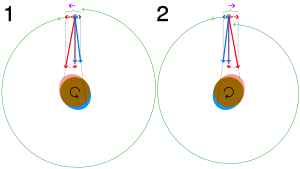Tidal locking
Tidal locking between a pair of co-orbiting astronomical bodies occurs when one of the objects reaches a state where there is no longer any net change in its rotation rate over the course of a complete orbit.[1] However, if both the difference in mass between the two bodies and the distance between them are relatively small, each may be tidally locked to the other; this is the case for Pluto and Charon, and for Eris and Dysnomia.Over many millions of years, the interaction forces changes to their orbits and rotation rates as a result of energy exchange and heat dissipation.When one of the bodies reaches a state where there is no longer any net change in its rotation rate over the course of a complete orbit, it is said to be tidally locked.[3] The object tends to stay in this state because leaving it would require adding energy back into the system.In the special case where an orbit is nearly circular and the body's rotation axis is not significantly tilted, such as the Moon, tidal locking results in the same hemisphere of the revolving object constantly facing its partner.[6] The gravitational force from object A upon B will vary with distance, being greatest at the nearest surface to A and least at the most distant.For large astronomical bodies that are nearly spherical due to self-gravitation, the tidal distortion produces a slightly prolate spheroid, i.e. an axially symmetric ellipsoid that is elongated along its major axis.The net resulting torque from both bulges, then, is always in the direction that acts to synchronize B's rotation with its orbital period, leading eventually to tidal locking.For example, Earth's rotation is gradually being slowed by the Moon, by an amount that becomes noticeable over geological time as revealed in the fossil record.Currently, atomic clocks show that Earth's day lengthens, on average, by about 2.3 milliseconds per century.[12] A widely spread misapprehension is that a tidally locked body permanently turns one side to its host.For orbits that do not have an eccentricity close to zero, the rotation rate tends to become locked with the orbital speed when the body is at periapsis, which is the point of strongest tidal interaction between the two objects.A Mercury-like terrestrial planet can, for example, become captured in a 3:2, 2:1, or 5:2 spin–orbit resonance, with the probability of each being dependent on the orbital eccentricity.[16] On the other hand, most of the irregular outer satellites of the giant planets (e.g. Phoebe), which orbit much farther away than the large well-known moons, are not tidally locked.Pluto's other moons are not tidally locked; Styx, Nix, Kerberos, and Hydra all rotate chaotically due to the influence of Charon.Modeling has demonstrated that Mercury was captured into the 3:2 spin–orbit state very early in its history, probably within 10–20 million years after its formation.Whether this relationship arose by chance or is the result of some kind of tidal locking with Earth is unknown.(perhaps conservatively, giving overestimated locking times), and where Even knowing the size and density of the satellite leaves many parameters that must be estimated (especially ω, Q, and μ), so that any calculated locking times obtained are expected to be inaccurate, even to factors of ten.may have been significantly different from that observed nowadays due to subsequent tidal acceleration, and the locking time is extremely sensitive to this value.A possible example of this is in the Saturn system, where Hyperion is not tidally locked, whereas the larger Iapetus, which orbits at a greater distance, is.However, this is not clear cut because Hyperion also experiences strong driving from the nearby Titan, which forces its rotation to be chaotic.Based on comparison between the likely time needed to lock a body to its primary, and the time it has been in its present orbit (comparable with the age of the Solar System for most planetary moons), a number of moons are thought to be locked.



In (2) with the rotation reversed, the net force opposes the satellite's direction of orbit, lowering it (tidal deceleration).



librationCharonbarycenterbinary systemorbitingastronomical bodiesrotation ratevariabilitysatelliteDysnomiagravitational interactionenergy exchangedissipationMercury'svariationsorbital velocityinclination of its rotation axisCenters of gravity in non-uniform fieldstorquegravitytidal forcesgradientequilibriumorthogonaltidal bulgessphericalprolate spheroidellipsoidangular momentumSynchronous orbitatomic clockslunar monthMoon's orbital periodred giantdwarf planetrotationorbital speedperiapsiseccentricMercuryexoplanetsSolar Systemlarge enough to be roundcubic functionirregular outer satellitesgiant planetsPhoebeKerberoschaoticallyasteroid moonscontact binariesfar side of the MoonSovietLuna 3parallaxeccentricityexoplanetProxima Centauri bProxima Centaurieyeball planetsbinary starsextrasolar planetsTau BoötisTau Boötis bradiansper secondsemi-major axisapoapsismoment of inertiamean radiusdissipation functiongravitational constantLove numbertidal accelerationHyperionIapetusPhobosDeimosJupiterAdrasteaAmaltheaEuropaGanymedeCallistoSaturnPrometheusPandoraEpimetheusEnceladusTelestoTethysCalypsoUranusMirandaUmbrielTitaniaOberonNeptuneProteusTritongiant planetDaphnisAegaeonMethonePalleneHelenePolydeucesCordeliaOpheliaBiancaCressidaDesdemonaJulietPortiaRosalindBelindaPerditaThalassaDespinaGalateaLarissaGliese 581cGliese 581gGliese 581bGliese 581eGliese 581